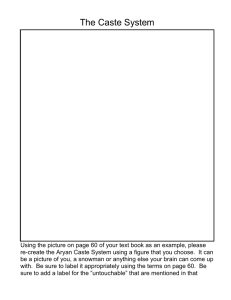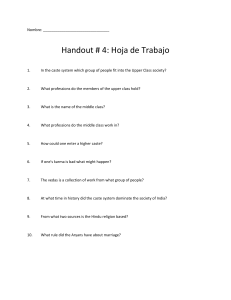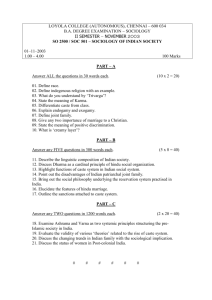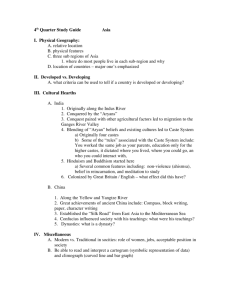Caste, Class, and Gender in India: A Sociological Analysis
advertisement
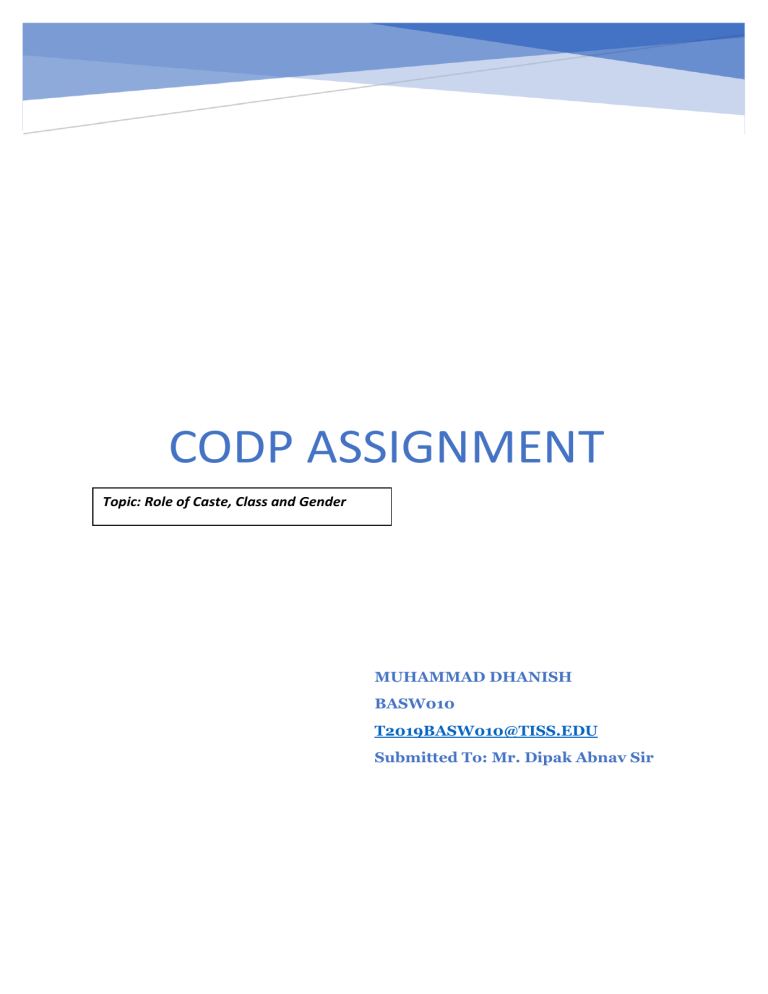
CODP ASSIGNMENT Topic: Role of Caste, Class and Gender MUHAMMAD DHANISH BASW010 T2019BASW010@TISS.EDU Submitted To: Mr. Dipak Abnav Sir The very roots of Indian society lie in the artificial social construction of Caste. The core factor in the social position of an individual is the privilege to which he is born into. In a totally divided nation like India, the caste roots even overstate the skills or talent a person as an individual have. The caste binary is visible in the social, economic, and every other structure of Indian institutions. Caste determines the opportunity a person gets in any institution directly or indirectly. While this social classification lies at the base of any discourse on Indian society, there are the other dimensions that cannot be missed out, especially class and gender. Indian social and political organization have primarily had a great privilege extended to those who are the so-called ‘forward castes’, male and from a well of income status. The social stigmas, prejudices and privileges of an individual or a community lies in their birth background. These are so deeply and systemically rooted into the core of Indian society and is glorified further through the historical narratives and interpretations that revolve around the aforementioned privileges. Thus, as expected, anything that is seen differing or less welcome to the privileged identities and backgrounds are considered ‘lower’ to the so-called ‘superior’ caste, class and gender. The brunt of such a social apocalypse is bore by the socially and economically marginalized sections of the society which includes the ex-untouchables, women, transgenders and such. As we look deeper into the bifurcations, caste is the foremost element of marginalization in Indian society. The subjects that are marginalized have a separate story to present when it comes to perspective of caste. Gender violence, for example, in India, have their own separate lineage and history when it comes to the violence and the brutality carried out against the lower castes and Dalit communities. Thus, even those classified into the broad ‘gender’ subject have its branch and difference when it comes to the consideration of caste perspectives in it. The violence perpetuated by the upper caste on the lower castes, thus is a different area of study that have its visible differences in the amount of violence and oppression seen. The caste rapes, for that instance, carried out by the powerful caste communities, is not only mere rapes but a campaign to instill fear and subjugation on the communities on whom it is being perpetuated upon. It is thus carried out to ensure the system is followed and no one dares to break the barriers put upon birth. In the same way, the social class of a person is made less significant if his caste doesn’t suit to be superior. Thus, the ‘inferior’ ones who are not to be on positions they must not be ‘morally’ or ‘traditionally’ are removed from those positions in a much more simplified way systematically. The system, which is dominated and run by the privileged removes those undesirables to it, until protected 1 affirmatively. This is very visible in the statistical analysis of any institutions of the countries where the majority of those represented arises from the savarnna or those deemed forward communities. The institutions have thus systematically removed those who are ‘considered’ to be unfit, in fact thus hegemonizing the 20% of population considered forward and oppressing the remaining of vast majority of the population. Class have a totally different involvement in defining the privileges and consolidation of its own base of privilege from reaching out to the lower sections of the society. Those who arise from a specific community to be richer and financially stable have a moral responsibility to uplift the fellow brethren still living under brutal oppression and extreme marginalization. This being said, it must never be on the shoulders of the so-called lower castes alone to battle the marginalization and oppression perpetuated by the state and the social structure. Speaking from a class perspective on gender, in a nation like India, economic status plays a major role from luring and bribing to influencing and obtaining media attention. Thus, class background plays a major role in how an identity is viewed and up to what extend an identity that is ‘viewed’ inferior can be acted against. Gender plays a major role in determining the status, social responsibility, mobility and every other exercise that an individual can have. The role of gender within the indexes of marginalization says a lot of how gender is seen in every strata of society. Gender is also a political tool not only in the Indian context, but also in the global image. In the Indian context, for example, the value and weight associated with the virginity of a female is a traditional concept carried out beyond caste and class boundaries. The patriarchal concept is thus made lively through the moral and historical strings that are attached to it. Gender roles are thus visible in every spectra of the Indian social and political engagements. They essentially lack representation in any of the governmental or non-governmental sectors with the absolute unequal treatment as well as wage pay gap in employment sectors. Many policies like the implementation of women reservation in government institutions and elections have made momentum to help in building a better context of gender equality. The aforementioned scheme, when analyzed critically can be seen that those women who won from reserved women seats in elections no longer qualifies in most of the time as the seat becomes a ‘general’ seat. Hence, the underlying argument that connects caste, class and gender is that the privilege that’s associated to be one among the ‘preferable’ social construction is undeniable and must 2 be acknowledged by those to whom the privilege was a part from their birth. It is the collective duty of the state and society to ensure that marginalization of any sort, be it systematic or unorganized, will never penetrate through. For this facts, the marginalized have to be supported by affirmative actions in support of their upbringing and must be closely watched in order to ensure a progressive and socially well developed nation. Education regarding the prejudices against any particular community is the basic core to combat the traditionally promoted evils that directly or indirectly cause the marginalization and otherisation of any community. 3 References: -Understanding Caste, Class and Gender by Lakshmi Lingam -TISSOL Presentation 4
